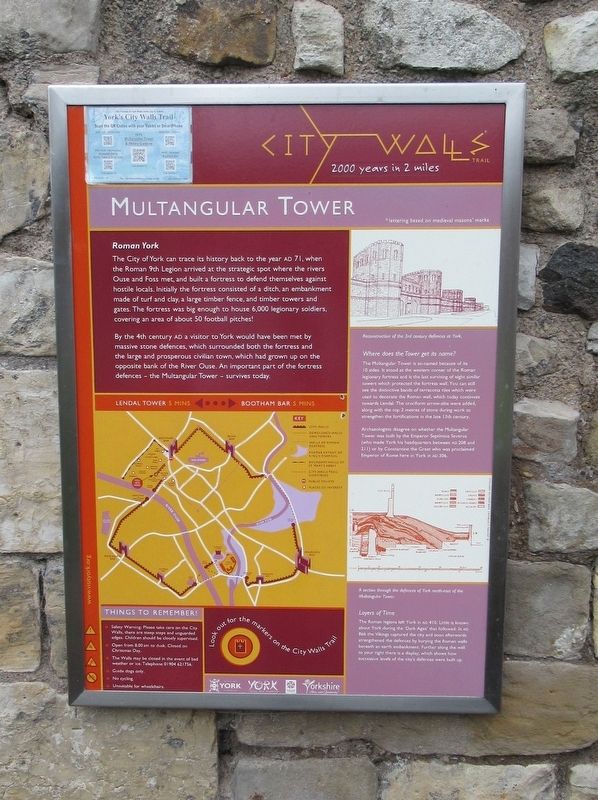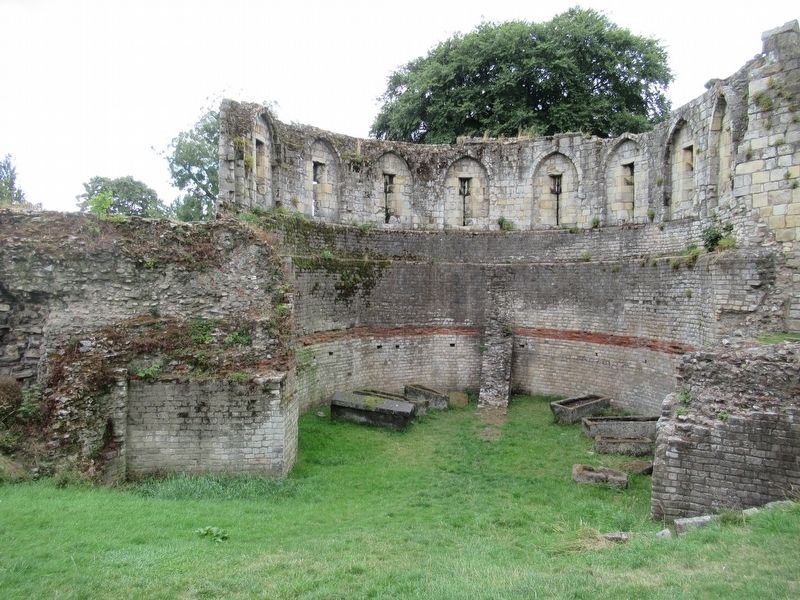York, England, United Kingdom — Northwestern Europe (the British Isles)
Multiangular Tower
200 years in 2 miles
Multiangular Tower
The City of York can trace its history back to the year AD 71, when the Roman 9th Legion arrived at the strategic spot where the rivers Ouse and Foss met, and built a fortress to defend themselves against hostile locals. Initially the fortress consisted of a ditch, an embankment made of turf and clay, a large timber fence, and timber towers and gates. The fortress was big enough to house 6,000 legionary soldiers covering an area of about 50 football pitches!
By the 4th century AD a visitor to York would have been met by massive stone defences, which surrounded both the fortress and the large and prosperous civilian town, which had grown up on the opposite bank of the River Ouse. An important part of the fortress defences - the Multangular Tower - survives today.
Where does the Tower get its name?
The Multiangular Tower is so-named because of its 10 sides. It stood at the western corner of the Roman legionary fortress and is the last surviving of eight similar towers which protected the fortress wall. You can still see the distinctive bands of terracotta tiles which were used to decorate the Roman wall, which today continues towards Lendal. The cruciform arrow-slits were added along with the top 3 metres of stone during work to strengthen the fortifications in the late 13th century.
Archaeologists disagree on whether the Multianglar Tower was built by the Emperor Septimius Severus (who made York his headquarters between AD 208 and 211) or by Constantine the Great who was proclaimed Emperor of Rome here in York in AD 306.
Layers of Time
The Roman legions left York in AD 410. Little is known about York during the ‘Dark Ages’ that followed. In AD 866 the Vikings captured the city and soon afterwards strengthened the defences by burying the Roman walls beneath an earth embankment. Further along the wall to your right there is a display, which shows how successive levels of the city’s defences were built up ( photo caption )
Reconstruction of the 3rd century defences at York
A section through the defences of York north-east of the Multiangular Tower
Topics. This historical marker is listed in this topic list: Forts and Castles.
Location. 53° 57.681′ N, 1° 5.223′ W. Marker is in York, England. Marker can be reached from the intersection of Museum Street (England Route A1036) and Lendal, on the left when traveling north. Located in Yorkshire Museum Gardens. Touch for map. Marker is in this post office area: York, England YO1 7FR, United Kingdom. Touch for directions.
Other nearby markers. At least 8 other markers are within walking distance of this marker. A different marker also named The Multiangular Tower (here, next to this marker); St. Leonard’s Hospital (within shouting distance of this marker); Yorkshire Philosophical Society (within shouting distance of this marker); Charles Allen Tree (within shouting distance of this marker); Voluntary Guides (within shouting distance of this marker); St Mary’s Abbey (about 120 meters away, measured in a direct line); Coat of Arms of Charles I (about 120 meters away); Lendal Tower (about 120 meters away). Touch for a list and map of all markers in York.
Credits. This page was last revised on January 27, 2022. It was originally submitted on October 23, 2018, by Michael Herrick of Southbury, Connecticut. This page has been viewed 108 times since then and 17 times this year. Photos: 1, 2. submitted on October 23, 2018, by Michael Herrick of Southbury, Connecticut.

